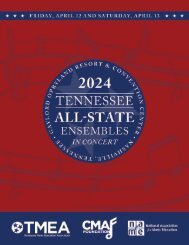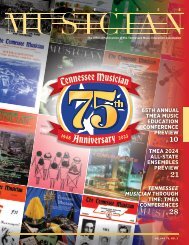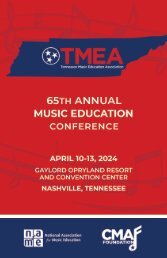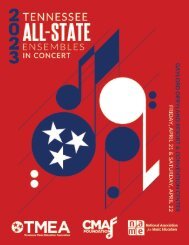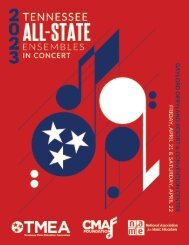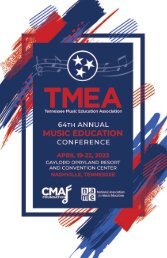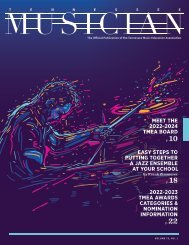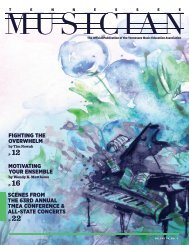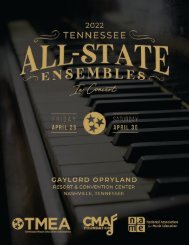TN Musician Vol. 71 No. 4
You also want an ePaper? Increase the reach of your titles
YUMPU automatically turns print PDFs into web optimized ePapers that Google loves.
INCLUDING<br />
LITERACY IN YOUR<br />
REHEARSALS<br />
Marcia Neel<br />
L<br />
iteracy can signify a diverse intention,<br />
and, in fact, our rehearsals can provide<br />
us with opportunities to teach literacy<br />
in every sense of the word. For purposes<br />
of this article however, literacy will<br />
refer to “artistic literacy” rather than<br />
literacy in the other academic areas.<br />
Created by the National Coalition for<br />
Core Arts Standards and released in<br />
2014, the National Core Arts Standards<br />
(NCAS) cultivate a student’s ability to<br />
carry out the four (4) Artistic Processes<br />
of Creating, Performing, Responding<br />
and Connecting.<br />
If we think back about our most<br />
rewarding musical experiences, many of<br />
us would be able to clearly articulate the<br />
specifics about the piece, the conductor,<br />
the location of the performance and<br />
where we were in our lives at that time<br />
in general terms. In fact, a question<br />
that I used to ask prospective music<br />
educators in the interview was, “tell me<br />
about the most rewarding performance<br />
experience you ever had.” The reason<br />
for this inquiry was to ensure that<br />
the candidate could specifically<br />
communicate what it takes to provide<br />
this type of experience for others. In<br />
almost every case, interviewees would<br />
respond that the reason they had this<br />
significant “experience” was because<br />
they were thoroughly prepared musically<br />
and also possessed a deep understanding<br />
of the work being performed. Think<br />
about it —shouldn’t every rehearsal lead<br />
to a performance where all of the musicmakers<br />
are confidently prepared both<br />
musically and intellectually?<br />
Yes, but the concern often arises that<br />
directors just don’t have the time to work<br />
with those “other” processes. Performing<br />
is what comes easiest however it also<br />
goes without saying that high-quality<br />
performances come about as a result<br />
of in-depth study and preparation. The<br />
Teaching Music Through Performance<br />
series published by GIA has provided a<br />
model to emulate. Each work presented<br />
provides a Teacher Resource Guide made<br />
up of specific units as follows:<br />
Unit 1: Composer<br />
Unit 2: Composition<br />
Unit 3: Historical Perspective<br />
Unit 4: Technical Considerations<br />
Unit 5: Stylistic Considerations<br />
Unit 6: Musical Elements<br />
Unit 7: Form and Structure<br />
Unit 8: Suggested Listening<br />
Unit 9: Additional References<br />
and Resources<br />
Having this type of comprehensive<br />
information at our fingertips provides<br />
us with the depth of knowledge required<br />
to fully prepare our students for<br />
studying, and eventually performing, a<br />
specific work.<br />
But what about Creating, Responding<br />
and Connecting? (The music standards<br />
consider Connecting to be embedded in<br />
the processes of Creating, Performing,<br />
and Responding) The ideas provided<br />
below are from directors who have<br />
found a way to incorporate these Artistic<br />
Processes into their curriculum.<br />
CREATING. Today’s young people are<br />
1 creating their own music more than<br />
ever and the vast majority of them are<br />
not in our ensemble classes! What is it<br />
about creating that leads so many young<br />
22 | TENNESSEE MUSICIAN | 2019 | <strong>Vol</strong>ume <strong>71</strong>, <strong>No</strong>. 4



